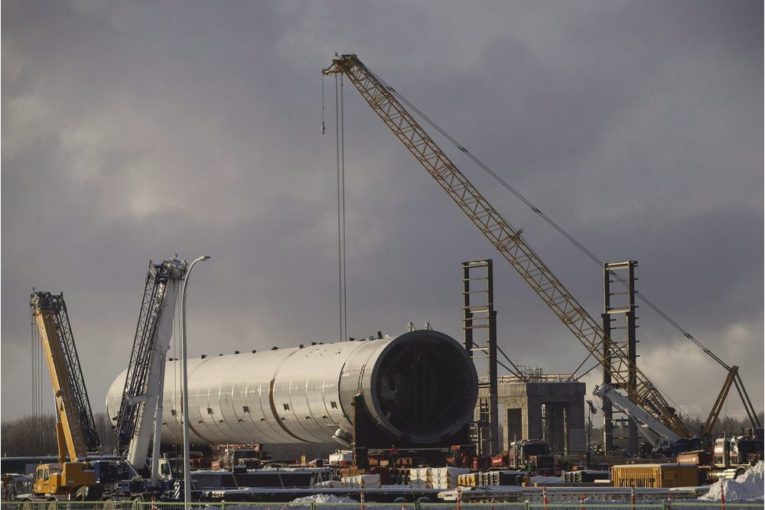
In the grips of an Alberta chill — both from brutal winter weather and the drop in energy investment — Monday’s announcement of a new $4.5-billion petrochemical facility felt like a chinook rolled into the province.
It took a while to arrive, but it’s a welcome respite.
Calgary-based Pembina Pipeline Corp. and its international partner — the petrochemical arm of Kuwait Petroleum Corp. — gave the green light to a propane dehydrogenation plant and polypropylene upgrading facility, located northeast of Edmonton.
The Canada Kuwait Petrochemical Corp. joint-venture will use about 23,000 barrels per day of propane from Western Canada and propel it along the value chain.
The complex will eventually turn it into polypropylene, used to make an array of plastic products, from food containers and consumer electronics to automobile parts.
For the industry and Alberta government, which is offering billions of dollars in incentives to kick-start additional petrochemical and energy infrastructure investments, Monday’s news represents progress.
“It reaffirms that Canada and Alberta, in particular, have gone back to its place as a globally significant chemical producer,” said Bob Masterson, chief executive of the Chemistry Industry Association of Canada.
“This reconfirms that Alberta’s back in the business.”
In a province thirsty for private-sector investment, it’s opportune timing.
Construction comes as new large-scale oilsands developments have largely wrapped up.
The facility is expected to be operating by mid-2023, subject to environmental and regulatory approvals.
The project will receive $300 million in provincial royalty tax credits, a decision first announced by the Notley government in December 2016.
Part of the lure for building in Alberta is Western Canada’s massive supply of cheap propane.
The shale-gas revolution has provided “unprecedented growth in liquids-rich drilling” across North America, triggering an oversupply of propane across the continent, according to company documents.
Current production out of Western Canada exceeds domestic propane demand by a factor of four times, it notes.
Once operating, the plant will have the capacity to produce 550,000 tonnes of polypropylene annually. Plastic pellets would be shipped to market, including to customers in the United States, by rail.
Canada currently relies on imported polypropylene to meet domestic demand.
The size of the project is world-scale. It will be the largest polypropylene facility of its kind in North America, said Joel Morales, an industry expert with consultancy IHS Markit.
The announcement comes as global demand for polypropylene is growing at a fast clip for areas such as medical products and so-called “white goods,” including refrigerators and washing machines.
According to IHS, the global polypropylene market is expected to expand by more than 20 per cent between 2018 and 2023.
Morales noted propane makes up about half the delivered cost of polypropylene to North American markets today, illustrating the strategic importance of such complexes having access to cheap feedstock.
“Plants in Canada are more expensive to build than in the U.S. Gulf Coast, but you only build a plant once, and the idea is you enjoy the cost advantage for a longer period of time on your propane,” Morales said from Houston.
Monday’s announcement comes as the province looks to lure significantly more investment and jobs into the petrochemical sector.
Aside from Pembina’s project, Inter Pipeline Ltd. is already building its Heartland Petrochemical Complex, a $3.5-billion polypropylene facility northeast of Edmonton, which is receiving $200 million in provincial royalty credits.
Last year, the Notley government announced a second round to its petrochemical program. It’s now providing $2.1 billion in additional loan guarantees, grants and royalty credits to attract additional petrochemical complexes, as well as new natural gas midstream projects.
Economic Diversification Minister Deron Bilous said Monday the province has a short list in place and he expects further announcements in the coming weeks.
Attracting new investment and creating demand for Alberta’s oil and gas resource is essential, given the current market-access problems in Canada.
But how far should Alberta open up its wallet to compete with other jurisdictions to nab such projects?
Masterson said the unwillingness to provide incentives in the past caused Alberta to miss out on potential petrochemical developments, such as more than 300 global-scale projects headed for the U.S. over the past five years.
Allan Fogwill, chief executive of the Canadian Energy Research Institute, noted incentives in the United States are higher than in Alberta.
Royal Dutch Shell’s new petrochemical facility being built in Pennsylvania is expected to receive tax credits worth an estimated $1.6 billion over 25 years.
“The problem is that Alberta didn’t start the incentive game, but everyone is playing it,” said Fogwill.
Aside from any risk tied to government financial commitments, there is also an opportunity cost to the province in committing more than $2 billion for these ventures.
“This is a game we should not want to play,” said University of Calgary economist Trevor Tombe. “The subsidies come at a cost. This is not a free lunch for the province.”
Bilous isn’t deterred.
He believes the program will help Alberta get off the boom-and-bust oil roller-coaster, and the project will create at least 200 direct positions once it’s operating.
“It’s levelling the playing field, it is not corporate welfare,” Bilous said in an interview.
“It’s companies that have said, ‘You level the playing field and we’ll be here.’”
United Conservative Party MLA Prasad Panda said his party supports energy diversification, but if elected in the upcoming election, it would review any contracts announced by the NDP government in the coming weeks to determine if they’re prudent for Albertans.
“If there’s no hanky-panky and if it’s not a risk to taxpayers, we will support them if they stand on their own merit,” he said.
A spring election, whenever it’s called, remains weeks away.
Right now, any break in the chilly climate — for investment or the weather — will be appreciated by all Albertans.
Chris Varcoe is a Calgary Herald columnist.
c
You can read more of the news on source
